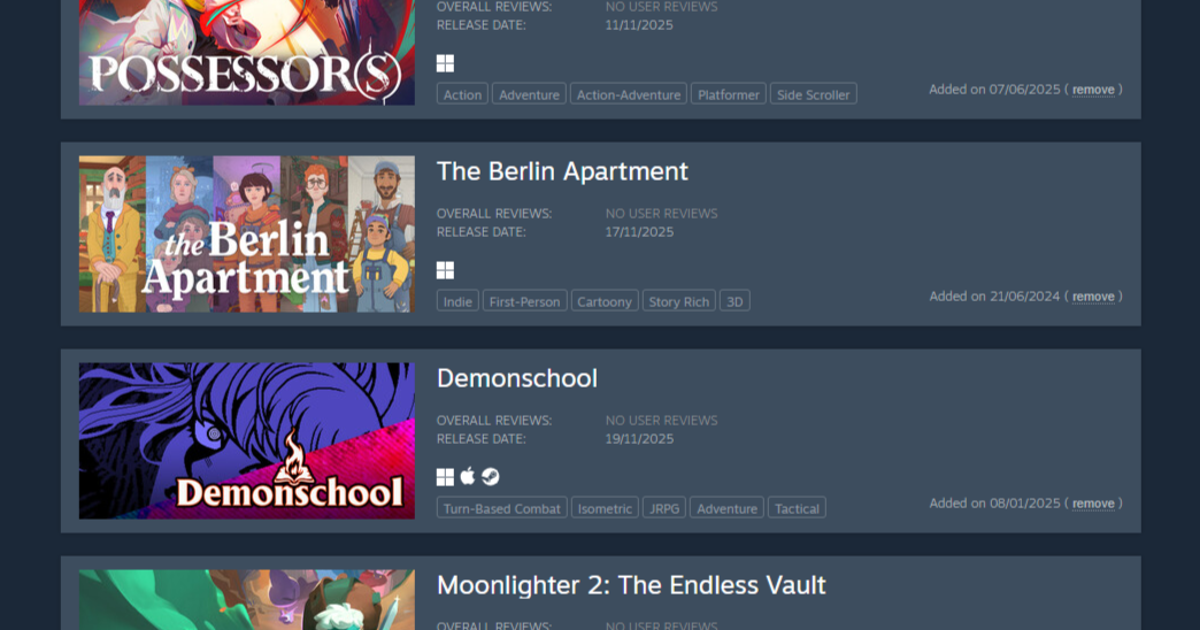Beyond the wishlist: A modern approach for predicting game success | Opinion
Eden Chen is the CEO and founder of Pragma, which is behind the playtesting and community management platform FirstLook.
Ever since digital became the dominant way of distributing PC games, Steam wishlists have been the main way to predict their commercial success. The thinking, understandably, is that more wishlists will mean more sales.
That rule of thumb may have broadly worked for a while, but it doesn’t hold up to scrutiny anymore. Conversion rates have dropped, and high-profile flops have meant that player trust in pre-orders is shakier than ever. Studios that lean too hard on wishlists are getting surprised with lacklustre launches and crickets where there should be players.
That doesn’t mean wishlists are useless. They still play a role in visibility and signaling interest. But they only tell a small part of the story. A wider set of signals is needed – one that provides a much more accurate picture of engagement, community, and staying power.
Predicting success isn’t just about forecasting sales. It shapes your marketing, IP strategy, and how studios talk to publishers and investors. Wishlists can’t give you all that. More signals can.
What wishlists get you (and what they don’t)
The industry became obsessed with wishlists for a reason. They can boost visibility in the Steam algorithm by getting your game into the ‘Popular Upcoming’ tab, keep it top of mind during launches and discounts, and make it show up in friends’ feeds.
But they don’t always equal purchases. Some players wishlist everything and buy ever so little. Others add a game to support a studio but never follow through. A Video Game Insights study showed that momentum only really starts to snowball if you break through 100,000 wishlists, something only about 6% of games ever achieve. Most sit closer to 10,000 or less.
And even when you do achieve impressive wishlist numbers, that doesn’t necessarily translate into long-term success. High wishlist counts can create a strong launch moment, but not necessarily sustained engagement if the content or retention loop isn’t there. Many games launch with hundreds of thousands of wishlists, but struggle to keep players after release.
So if you’re building a new IP or running an indie studio, relying solely on wishlists as an indicator can leave you flying blind.
Community as the leading signal
The better way to predict success is to measure community health and playtest retention. That means looking at what players actually do before and after they wishlist. Are they joining your Discord and coming back regularly? Are influencers covering your game organically? Is sentiment on Reddit, YouTube, or TikTok moving in a positive direction? Are players bringing in their friends?
These are the signs that matter most. A single wishlist click shows fleeting interest, a moment of weakness, a non-committal throwaway action. Repeat playtests, ongoing comments, and a growing community show real commitment. When people get involved in your community, they invite their friends, creating a snowball effect that can exponentially grow your player base. A wishlist is just a wishlist; community activity compounds.
And the good news is you can start measuring this early. Long before launch, you can track Discord growth, analyse feedback, and see which social content drives repeat engagement. The earlier the better, and the more confidently you will be able to forecast sales and retention.
How to separate signal from noise
Not all buzz means your game will last. The trick is to identify the signals that map to sustained engagement.
For example, a spike in wishlists after one viral post is great, but it might not mean much in the long run, whereas a group of players returning for multiple playtests is a much stronger indicator. A Reddit thread with hundreds of comments matters less than a smaller community that engages every day of the week.
When you look at influencers, don’t just count how many are posting or playing, or even their reach. Pay attention to how their audience responds, and whether the same themes keep surfacing across channels.
Early on, you can do this tracking manually. As you scale, you’ll need dedicated community managers and tools that make sense of the data. Either way, the point is to focus on repeatable signals, not one-off spikes.
Why this matters
Hard data about community engagement and retention is more than just a forecasting tool. It’s a secret weapon.
This means AAAs can de-risk their game launches, making an informed decision about whether they’re likely to end up with money in their pocket, the tweaks they need to implement to make that a reality, or even whether to walk away from an in-development title before it’s too late. Bringing execs and shareholders along on the journey is a lot easier when it’s rich in data.
VCs and publishers are moving away from wishlist counts as the primary measure of traction
Likewise, for indies looking for a publishing deal or investment, VCs and publishers are moving away from wishlist counts as the primary measure of traction. What they care about is proof of momentum. If you can show that your community is growing, feedback is being acted on, and players are sticking around, you walk into the room with a much stronger story.
There’s a famous, frequently misquoted line from the 1989 Kevin Costner movie Field of Dreams: “If you build it, they will come” (it’s actually “he will come” in the film). In the case of games marketing, this doesn’t refer to the titles themselves, but to the communities around them. The studios that build community from the ground up – measuring health, sentiment, and retention – will not only predict success, but generate it.








Add comment